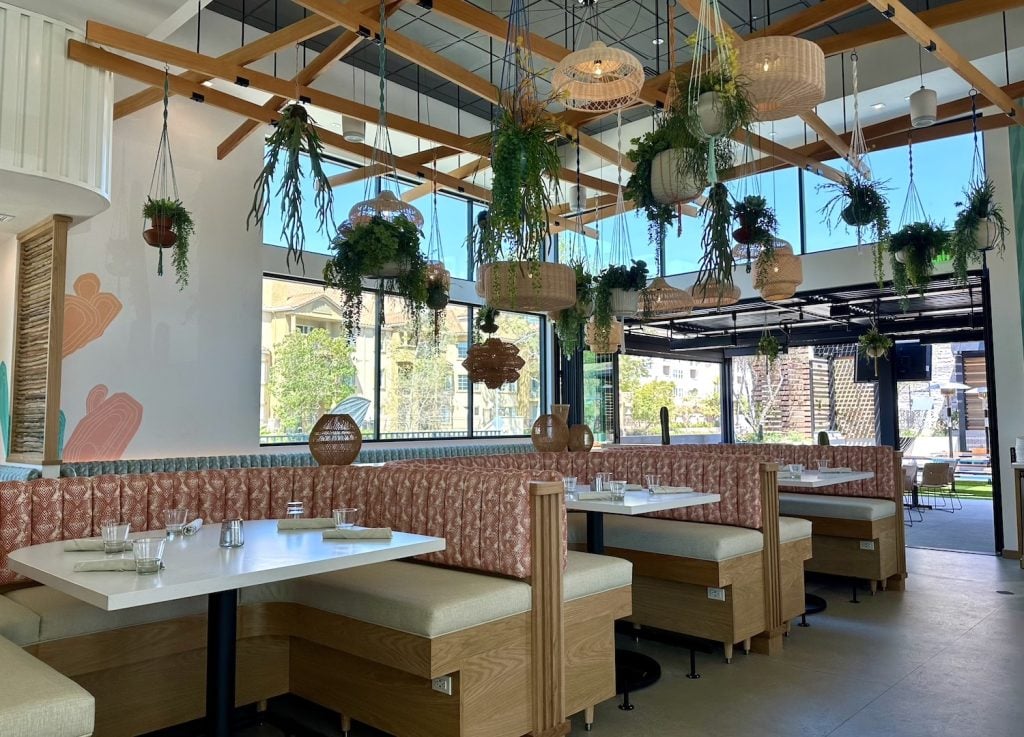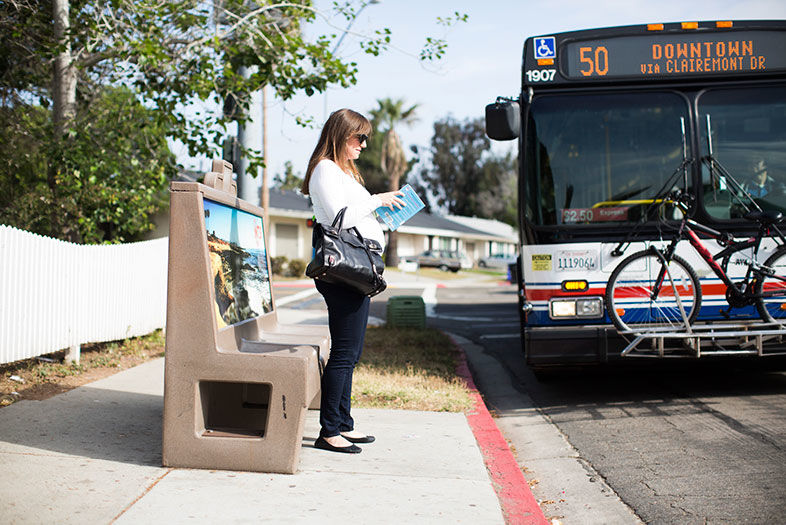On any given day, this magazine’s staff of 28 people drives and parks 25 cars in the garage on Broadway between Seventh and Eighth avenues (our three outliers: a regular Coaster rider from Vista, a scooter commuter who uses 12 gallons of gas per year, and a Harley-Davidson enthusiast known to 4,800 Instagram followers as “Cylinderella”). So 89 percent of us commute to downtown by car. No one carpools. As a group, we closely represent San Diego County residents as a whole, where 85 percent of people get to work via automobile each day. (The remaining walk, bike, take public transit, or telecommute.) That’s a pretty bleak portrait of how our city utilizes its $243 million* mass transit system. Since 1 million people will move or be born here in the next 35 years**, SANDAG’s got all kinds of plans to increase ridership and make it easier for people to walk and bike. After reading that the Climate Action Plan calls for the number of public transit commuters to increase by 15 percent, cyclists to increase 17 percent, and walkers to increase six percent, we decided it was time to finally try not driving.
Of the 28 staffers we encouraged to join the experiment, 13 pledged to try it that day, a Wednesday. The parameters were simple: Get to work on time without a car. Carpooling was okay, as long as you had at least three people in the car (we had one carpooling trio). Now at least we can all talk about it from experience. As for what we learned? Life is still a highway, at least for now.
El Cerrito (10-mile commute)
Jim Ely, 49, Account Manager
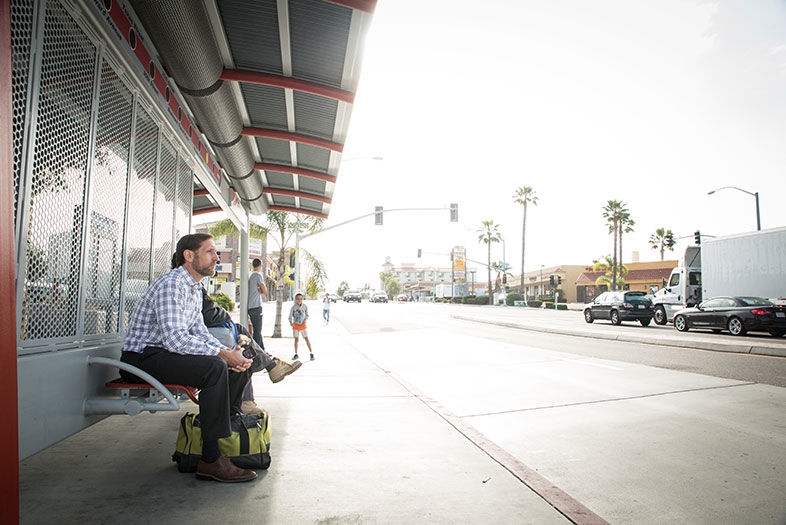
Stopping Traffic
INSTEAD OF HIS CAR: RAPID bus down El Cajon Boulevard
COST: $4.50 roundtrip
ON A REGULAR DAY: “My length of commute can vary greatly. It’s 20 minutes on a good day. It can take 50 minutes if there’s an accident on 94 or on Montezuma. Every day I listen to the traffic report or use SigAlert.”
PEACE AND QUIET: “It was great to walk to and from the bus in the morning. I realized how stressful driving is. It’s not a way to start the day. Instead, I was able to text and look around. The bus was clean and comfortable. But I wouldn’t want to take the bus at 11 p.m. On this particular day, my husband Michael met me at the gym after work and drove me home.”
DO IT AGAIN? “Definitely. I would have to plan for a day I don’t need to drive to a meeting or run errands.”
SOAPBOX: “I don’t think people realize that the trend is moving away from the automobile. People want to walk, ride or take public transportation. Clogging the highways is not good for the environment or one’s quality of life. The bus was a great way to get to work for me. Piece of cake. But, I’m lucky. The rapid line was easily accessible. For most it is still a nightmare.”
Vista (40-mile commute)
Corey Hollister, 32, Art Director
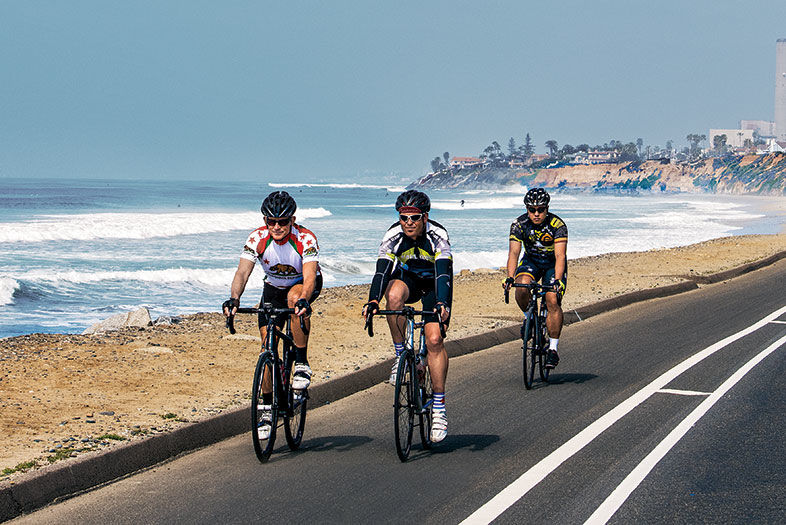
Stopping Traffic
COREY JENKINS
INSTEAD OF HIS CAR: Bike or Coaster
COST: $160 monthly pass
BY BIKE: “I bike to work two to three times per month. I leave my home at 6:45 and get to work before 9. It takes only 30 minutes more than commuting on the Coaster. But I have to check my gear, bring my clothes and towel the day before to shower in the basement gym.”
ON MOST DAYS: “I take the Coaster. Door-to-door, it takes 1.5 hours including walking 12 minutes from Santa Fe Station. And my drive to the Coaster in the morning takes 15 to 20 minutes because it’s rush hour.”
EASY RIDER: “The Coaster is quiet—people are sleeping or wearing earbuds. I listen to podcasts. Half the train gets off in Sorrento Valley. There are buses for Qualcomm. I sit in the same car and see familiar faces.”
CAR VS. COASTER: “I take my truck occassionally, if I’ve slept in or I have a photo shoot. The gas costs $18 per day, plus wear and tear. The Coaster is about $7 or $8 per day. When I drive, I miss the Coaster. It takes an extra half-hour, but it’s relaxed, quality time.”
Carmel Valley (20-mile commute)
Chelsea Street, 22, Sales Assistant
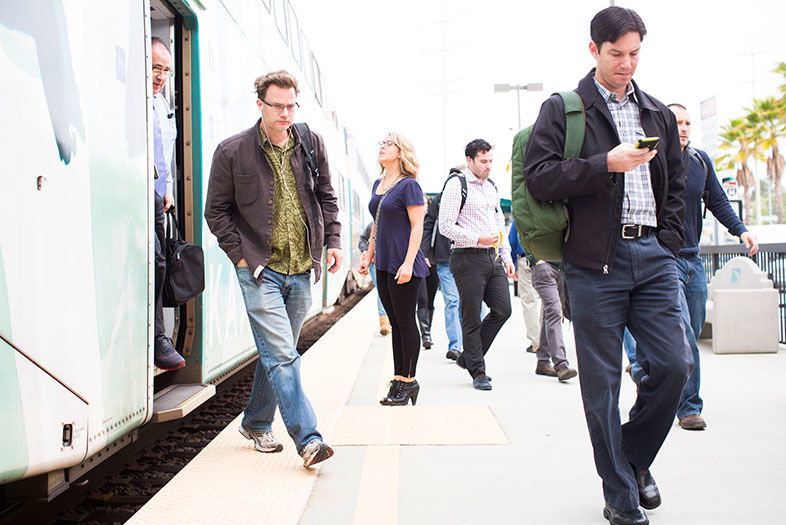
Stopping Traffic
Jay Reilly
INSTEAD OF HER CAR: Coaster, $10, roundtrip
USUALLY: Drive 30 minutes. “I get 46 miles per gallon with my Prius, so it’s $5–$6 per day for gas.”
ROUTE: “I drove to Sorrento Valley. Because of a construction mess, I missed the 7:50 coaster. I got the 8:15 and made it to the office a bit late.”
ON THE TRAIN: “It was clean, quiet, and I got to read a book.”
MONEY MATTERS: “Fiscally, it doesn’t make any sense. I wish it did.”
TIME: “It is more than double my normal commute. But it opened my eyes to San Diego.”
DO IT AGAIN? “I did it again the next week. My car was in the shop, so I dropped it off and hopped on the train. It was easier the second time around because I knew what I was doing.”
Pacific Beach (11.4-mile commute)
Taylor Flores, 29, Production Manager
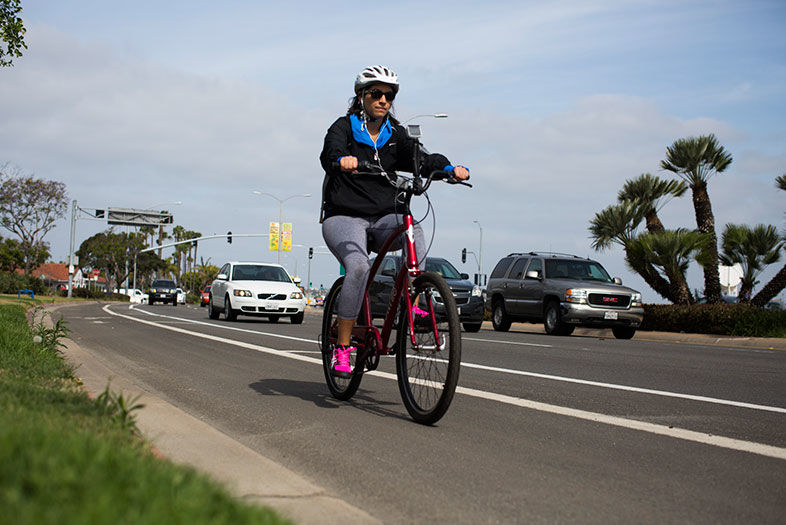
Stopping Traffic
Jay Reilly
INSTEAD OF HER CAR: Bike
COST: Free!
TOTAL TIME: 1 hour 5 minutes
BAGGAGE: Change of clothes, makeup, lunch. “After work, I had to change back into my sweaty bra.”
DITCH THE GYM? “No. I like to do boot camp and weights.”
SAFETY CONCERNS: “Going into the O.B. area and into Point Loma, I was terrified for my life. They have bike lanes, but the signage was poor. I only knew which way to go because I had done my research. On the way back—Sunset Cliffs to O.B. to P.B.—there was an intersection where you can take a freeway. There was no sign that you are supposed to go through a small opening between two concrete barriers on a separate path from the cars. So I had to become a car. The cars were so close to me I could not turn around. I had to wait for a light, then back up, pick up my bike, and lift it over the guardrail.”
CONSIDERATIONS: “On the way back, I didn’t know how tired I would be, or how dark it might get. I’m not experienced enough.”
DO IT AGAIN? “I hope so. I felt very accomplished.”
Tierrasanta (13-mile commute)
Laurie Nicoud, 31, Creative Director
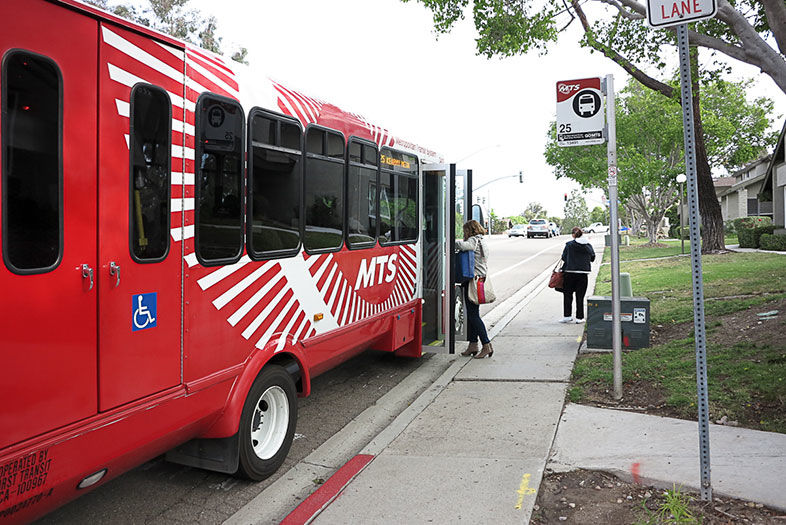
Stopping Traffic
INSTEAD OF HER CAR: Bus RAPID
COST: $4.75 one way
BAGGAGE: Purse, breast pump, and a coffee.
THE ROUTE: “My husband drove me to the bus stop because it would have taken 30 minutes to walk. We had to pack our seven-month-old into the car for this short drive. The bus was more of a van—nice and new. Only four people were on it. For the second bus, I took the RAPID Line at Clairemont Mesa and Ruffin. It took 30 minutes to get downtown. It was extra-long with an accordion in the middle, but pretty empty.”
DO IT AGAIN? “I’d be open. But I would drive to the shopping center of the RAPID Bus and skip the first bus.”
North Park (4-mile commute)
David Martin, 36, Digital Media Director
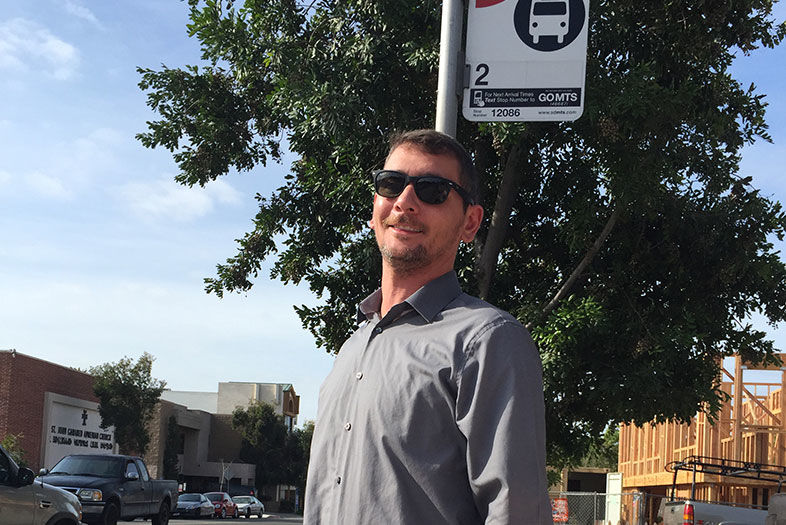
Stopping Traffic
INSTEAD OF HIS CAR: #2 bus
COST: $4.50 roundtrip
EFFICIENCY: “There was only one other person on the bus, and he got on with me. By the time we got downtown, it was at about 60 percent to 70 percent capacity.”
CROSSING OVER: “I enjoyed the bus. It was 30 minutes of relaxed time. I checked email, listened to music. I was dropped off right in front of the office downtown. On the way back, it was super relaxing. I stopped for a beer. I would definitely do it again. I only had to get up 15 to 20 minutes earlier, and then was able to take ‘me time.’ There were a lot of hipsters on the bus. One had big ol’ gauged ears and a giant beard. It was fun to look at 30th Street in a different way, because I’m always driving.”
Bay Park (9-mile commute)
Erin Meanley Glenny, 36, Executive Editor
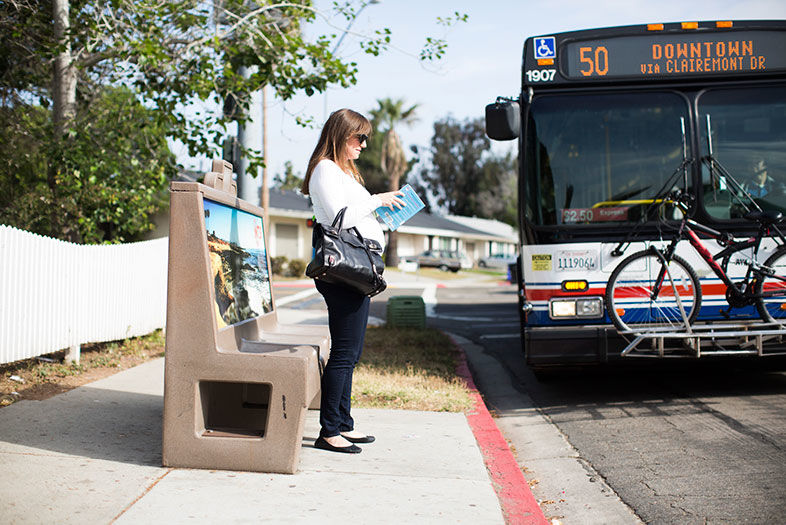
Stopping Traffic
Jay Reilly
INSTEAD OF HER CAR: #50 Express Bus
COST: $5 roundtrip
COMPARISON: “It took twice as long as driving, and I’d still need a car because I take my stepson to school [20 minutes inland], and I need it on weekends. Well, ‘need.’”
EFFICIENCY: “When I boarded to go home, there were only three riders including me. This was at rush hour, on a double-length bus, in the heart of downtown. One rider got off a block later. The max number of riders was probably on the freeway: 11 out of 45 seats were filled. What a waste.”
THE FORCE: “I grew up in San Diego, fully immersed in the car culture. I never got on a bus or trolley here. But I began my career in New York City where, unless you are upper-class, you must rely on public transportation. Out of necessity, it’s a way of life. I think if mass transit is anything but a necessity, people will opt for the car. I love having my personal space and being able to leave items like a gym bag in the car, and I cherish the control and freedom to leave a place exactly when I want, or be able to run an errand, or stop at an event on my way home. I burned out on public transportation in NYC. I wish I could slow down and warm up to it again, but I can’t see getting rid of my car permanently.”
Hillcrest (3-mile commute)
Archana Ram, 30, Contributing Editor
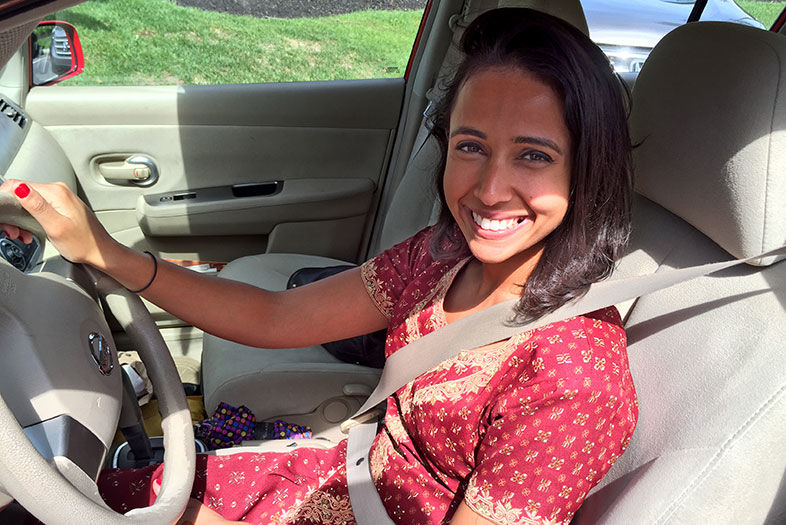
Stopping Traffic
INSTEAD OF HER CAR: Bus or Car2Go
COST: $4.50 roundtrip bus or $3.69 Car2Go one-way
ON THE BUS: “It’s a straight shot down Park Boulevard on the #7 bus. I often wait upwards of 20 minutes. You can text a number for a real-time schedule, but it’s not always accurate. The return trip is even more painful. After a long day of work, all I want to do is get home, but I’ve waited 20 to 25 minutes in the past.”
IT’S NOT FARE: “The fare system is nonsensical. They offer only monthly and day passes, and since I fall somewhere in between, I’m stuck paying $2.25 per ride. Make sure to have exact change! I’m always hoarding dollar bills and quarters.”
MY OTHER CAR IS A… “Smartcar sharing service Car2Go is like a breath of fresh, Silicon Valley air. You search for vehicles nearby and reserve them up to 30 minutes in advance. When you get to the car, swipe your card and go—within city limits. You don’t have to pay for parking, thanks to a deal with the city!” (Car2Go is $35 sign-up fee; 41 cents per minute.)
Gaslamp (0.7-mile commute)
Sydnie Goodwin, 25, Associate Art Director
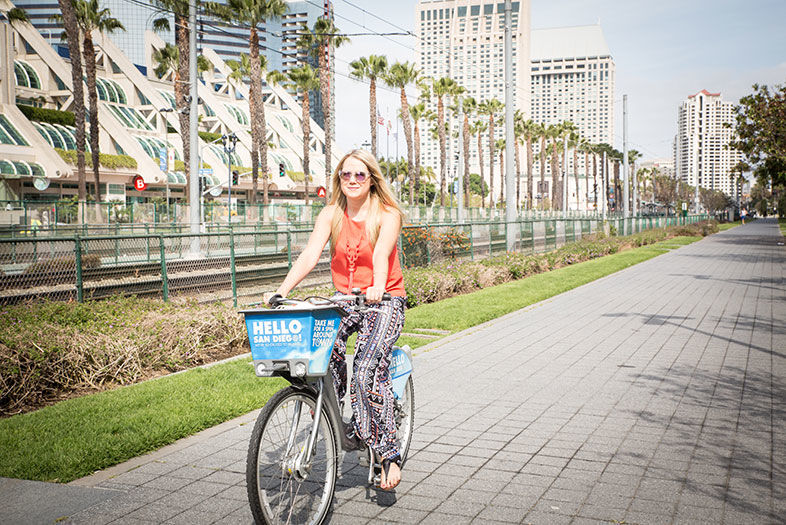
Stopping Traffic
INSTEAD OF HER CAR: DecoBike
COST: $5 for 30 minutes
ON A TYPICAL DAY: “I usually drive my car from my apartment on K Street. Sometimes I need my car to get to photo shoots. Halfway through my commute, I stop and park at Starbucks. They know my order.”
ON THE DECOBIKE: “I didn’t have a helmet, and there was no cupholder for my Starbucks, so I didn’t stop. On Seventh Avenue, there was construction and I felt like I was going to get hit by a car. My commute took seven minutes. On the way back, I walked because it was safer and cheaper—although I had saved on coffee that morning.”
THREE WEEKS LATER… she has walked to work twice.
Allied Gardens (10-mile commute)
Erin Smith, 33, Editor
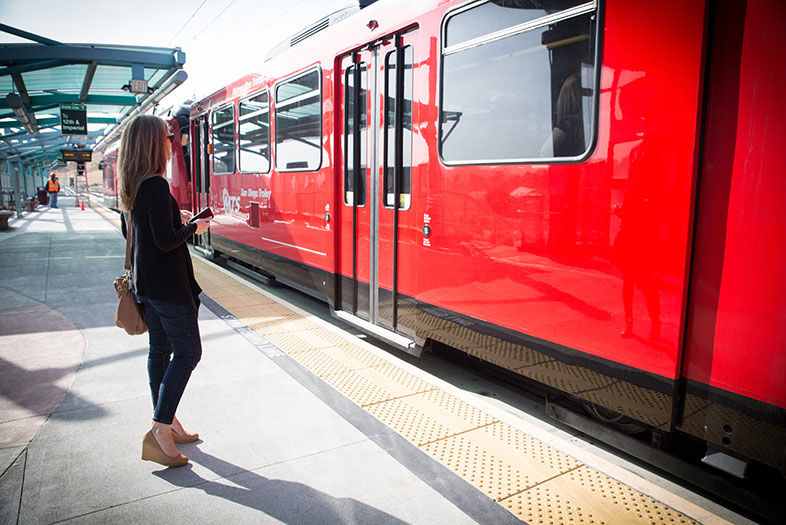
Stopping Traffic
INSTEAD OF HER CAR
Trolley
COST: $5 roundtrip
THE FIRST MILE: “I live one long, steep hill away from the Grantville station, so I drove and parked in the park-and-ride lot. The Green Line zoomed me to Santa Fe Station, then a bus took me the rest of the way.”
TIME LAPSE: “It took three times longer than my normal.”
SAFETY: “I felt uneasy in the evening at the Grantville station.”
RAID! “In Old Town, police officers boarded the train and asked to see tickets. Several people made a fuss and were escorted off. It was aggressive!”
REPEAT RIDER: “Because of childcare logistics, I think I could do this on Fridays. It does not save time or money, but I’d feel good about adding one less car on I-8.”
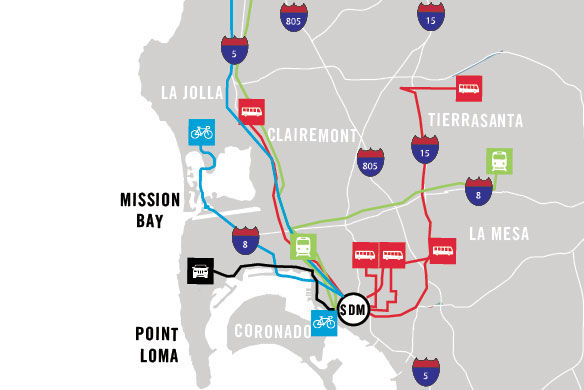
What We Learned

Issue: Gender Equity
*operating budget, fiscal year 2012
**according to the projections of the San Diego Association of Governments

Stopping Traffic
Photos by Jesse Bowen & Jay Reilly


